Unit 12 Innovation Reading club 1课件 (共18张PPT,内镶嵌4视频) 2024-2025学年高二英语北师版(2019)选择性必修4
文档属性
| 名称 | Unit 12 Innovation Reading club 1课件 (共18张PPT,内镶嵌4视频) 2024-2025学年高二英语北师版(2019)选择性必修4 | 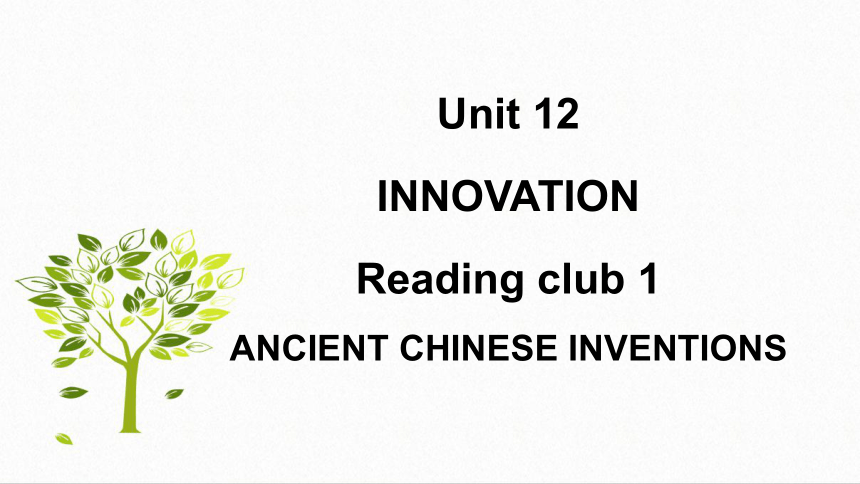 | |
| 格式 | pptx | ||
| 文件大小 | 42.2MB | ||
| 资源类型 | 教案 | ||
| 版本资源 | 北师大版(2019) | ||
| 科目 | 英语 | ||
| 更新时间 | 2025-04-28 10:46:28 | ||
图片预览


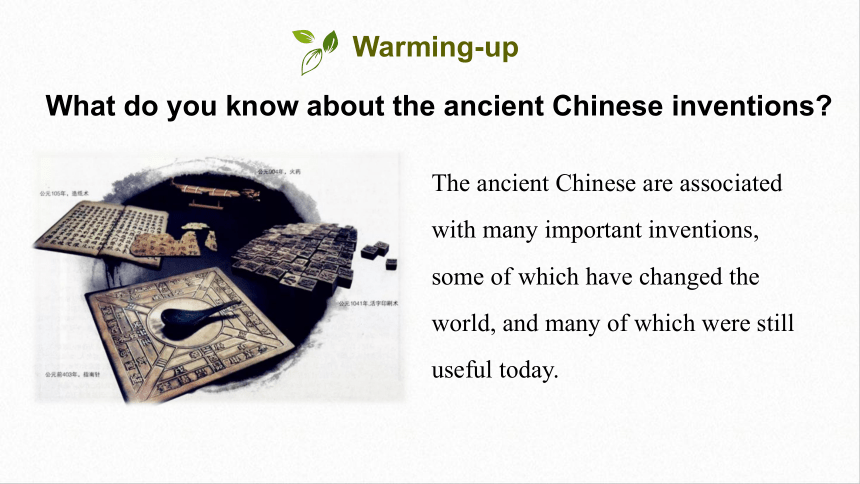
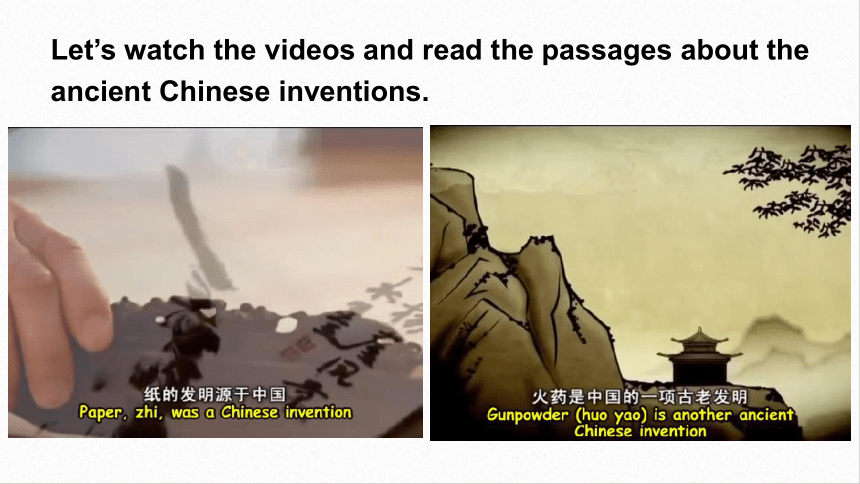
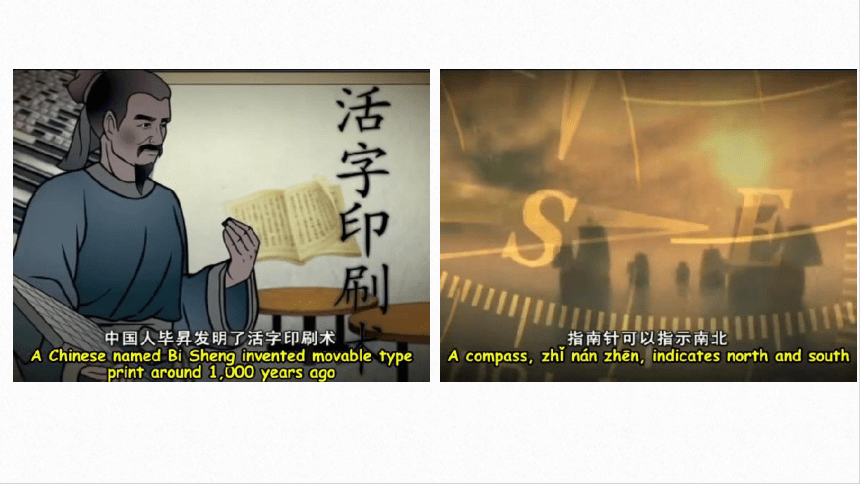
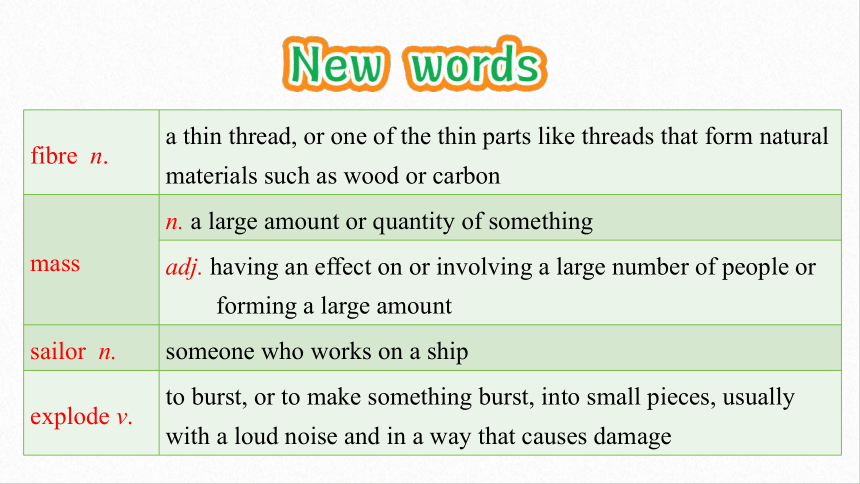
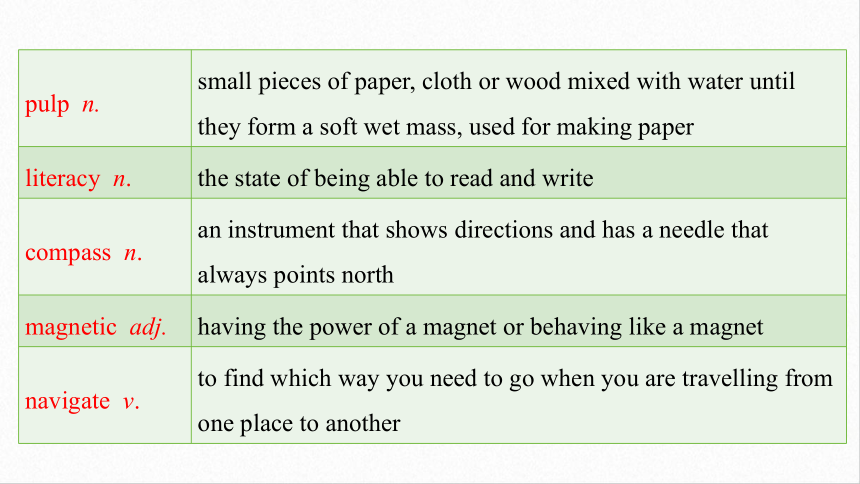
文档简介
(共18张PPT)
Unit 12
INNOVATION
Reading club 1
ANCIENT CHINESE INVENTIONS
To read about ancient Chinese inventions
To read for deep understanding and critical thinking
Learning objectives
What do you know about the ancient Chinese inventions
The ancient Chinese are associated with many important inventions, some of which have changed the world, and many of which were still useful today.
Warming-up
Let’s watch the videos and read the passages about the ancient Chinese inventions.
fibre n. a thin thread, or one of the thin parts like threads that form natural materials such as wood or carbon
mass n. a large amount or quantity of something
adj. having an effect on or involving a large number of people or forming a large amount
sailor n. someone who works on a ship
explode v. to burst, or to make something burst, into small pieces, usually with a loud noise and in a way that causes damage
pulp n. small pieces of paper, cloth or wood mixed with water until they form a soft wet mass, used for making paper
literacy n. the state of being able to read and write
compass n. an instrument that shows directions and has a needle that always points north
magnetic adj. having the power of a magnet or behaving like a magnet
navigate v. to find which way you need to go when you are travelling from one place to another
When did these Chinese inventions first appear in history How were they used
Paper was invented and used about 2,000 years ago in ancient China. It was used to produce historical records, maps and literature.
Bi Sheng invented the movable type printing in 1,045 AD. It made it much quicker and easier to reproduce written work and led to the first ever mass-production of books and literature.
Gunpowder was invented in the eighth century AD. It was used in wars and led to the development of many different kinds of weapons.
The first, simple compasses were made during the third century, and the Chinese were using highly developed compasses to navigate ships at sea.
Read the passages again and complete the blanks.
Paper making
Gunpowder
Printing
The Compass
Time of invention:_____
Made from:____
Process:_____________________
Significance:_________________
Time of invention:____
Used in:
_____________
Significance:
_____________
_____________
Time:_____
Inventor:____
Early printing presses were made by:
____________
Significance:
____________
By ______, the first simple compasses were made by _____.
By _____, highly developed compasses were used to _______.
Time of invention:___________________
Made from: _______________
Process:
___________________________________
___________________________________
Significance:
___________________________________
___________________________________
___________________________________
about 2,000 years ago
bamboo fibre
The plant was put in water and then beaten to a pulp. Then it was dried into fine sheets.
China was one of the first nations to start producing historical records, maps and literature.
Paper making
Time of invention:______________________
Used in: _____________
Significance:
___________________________________
___________________________________
in the eighth century AD
wars
It led to the development of many different kinds of weapons.
Gunpowder
Time: ______________
Inventor:____________
Early printing presses were made by
___________________________________
Significance:
___________________________________
___________________________________
___________________________________
in 1045 AD
Bi Sheng
carving wooden blocks with characters.
This invention made it much quicker and easier to reproduce written work and led to the first ever mass-production of books and literature.
Printing
By __________________, the first simple compasses were made by
__________________________________
_________________________________.
By ______________, highly developed compasses were used to
______________________________.
the third century
floating small pins of magnetic metal in bowls of water
the 11th century
navigate their ships at sea
The Compass
How have the four inventions enhanced the quality of life for humans
With the invention and spread of papermaking, the carrier cost of characters has been greatly reduced, thus greatly promoting the development of science and technology and economy in the world.
This invention made it much quicker and easier to reproduce written work and led to the first ever mass-production of books and literature.
mass n. a large amount or quantity of something 大量,大宗
e.g. The forest is a mass of colour in autumn.
Masses of books covered every surface in the room.
【归纳】
a mass of / masses of 其后既可接可数名词,也可接不可数名词。
Language points
mass adj. involving or intended for a very large number of people 民众的,群众的; 大量的
e.g. Their latest product is aimed at the mass market.
Write a passage according to Activity 2.
Homework
Unit 12
INNOVATION
Reading club 1
ANCIENT CHINESE INVENTIONS
To read about ancient Chinese inventions
To read for deep understanding and critical thinking
Learning objectives
What do you know about the ancient Chinese inventions
The ancient Chinese are associated with many important inventions, some of which have changed the world, and many of which were still useful today.
Warming-up
Let’s watch the videos and read the passages about the ancient Chinese inventions.
fibre n. a thin thread, or one of the thin parts like threads that form natural materials such as wood or carbon
mass n. a large amount or quantity of something
adj. having an effect on or involving a large number of people or forming a large amount
sailor n. someone who works on a ship
explode v. to burst, or to make something burst, into small pieces, usually with a loud noise and in a way that causes damage
pulp n. small pieces of paper, cloth or wood mixed with water until they form a soft wet mass, used for making paper
literacy n. the state of being able to read and write
compass n. an instrument that shows directions and has a needle that always points north
magnetic adj. having the power of a magnet or behaving like a magnet
navigate v. to find which way you need to go when you are travelling from one place to another
When did these Chinese inventions first appear in history How were they used
Paper was invented and used about 2,000 years ago in ancient China. It was used to produce historical records, maps and literature.
Bi Sheng invented the movable type printing in 1,045 AD. It made it much quicker and easier to reproduce written work and led to the first ever mass-production of books and literature.
Gunpowder was invented in the eighth century AD. It was used in wars and led to the development of many different kinds of weapons.
The first, simple compasses were made during the third century, and the Chinese were using highly developed compasses to navigate ships at sea.
Read the passages again and complete the blanks.
Paper making
Gunpowder
Printing
The Compass
Time of invention:_____
Made from:____
Process:_____________________
Significance:_________________
Time of invention:____
Used in:
_____________
Significance:
_____________
_____________
Time:_____
Inventor:____
Early printing presses were made by:
____________
Significance:
____________
By ______, the first simple compasses were made by _____.
By _____, highly developed compasses were used to _______.
Time of invention:___________________
Made from: _______________
Process:
___________________________________
___________________________________
Significance:
___________________________________
___________________________________
___________________________________
about 2,000 years ago
bamboo fibre
The plant was put in water and then beaten to a pulp. Then it was dried into fine sheets.
China was one of the first nations to start producing historical records, maps and literature.
Paper making
Time of invention:______________________
Used in: _____________
Significance:
___________________________________
___________________________________
in the eighth century AD
wars
It led to the development of many different kinds of weapons.
Gunpowder
Time: ______________
Inventor:____________
Early printing presses were made by
___________________________________
Significance:
___________________________________
___________________________________
___________________________________
in 1045 AD
Bi Sheng
carving wooden blocks with characters.
This invention made it much quicker and easier to reproduce written work and led to the first ever mass-production of books and literature.
Printing
By __________________, the first simple compasses were made by
__________________________________
_________________________________.
By ______________, highly developed compasses were used to
______________________________.
the third century
floating small pins of magnetic metal in bowls of water
the 11th century
navigate their ships at sea
The Compass
How have the four inventions enhanced the quality of life for humans
With the invention and spread of papermaking, the carrier cost of characters has been greatly reduced, thus greatly promoting the development of science and technology and economy in the world.
This invention made it much quicker and easier to reproduce written work and led to the first ever mass-production of books and literature.
mass n. a large amount or quantity of something 大量,大宗
e.g. The forest is a mass of colour in autumn.
Masses of books covered every surface in the room.
【归纳】
a mass of / masses of 其后既可接可数名词,也可接不可数名词。
Language points
mass adj. involving or intended for a very large number of people 民众的,群众的; 大量的
e.g. Their latest product is aimed at the mass market.
Write a passage according to Activity 2.
Homework
同课章节目录
- Unit 10 Connections
- Lesson 1 How Closely Connected Are We?
- Lesson 2 Community Spirit
- Lesson 3 Anne of Green Gables
- Unit 11 Conflict And Compromise
- Lesson 1 Living In a Community
- Lesson 2 Dealing with Conflict
- Lesson 3 War Memories
- Unit 12 Innovation
- Lesson 1 Scientific Breakthroughs
- Lesson 2 Aha Moment
- Lesson 3 Stephen Hawking
